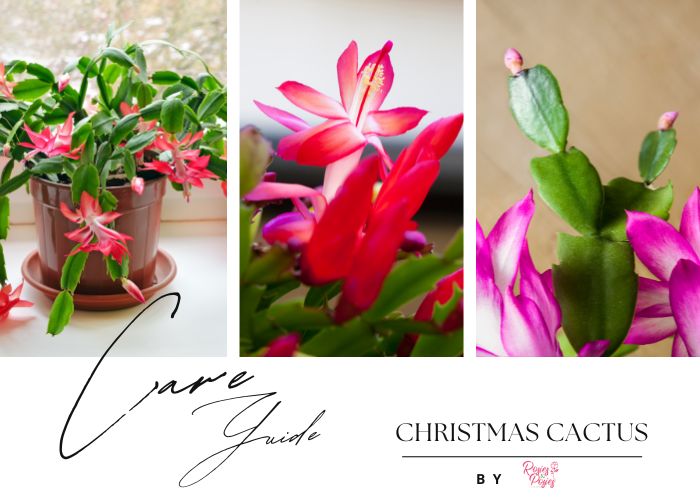Christmas Cactus Care
Discover the charm of Christmas cactus with Rosies and Posies! Explore our exquisite collection of holiday succulents that bloom in winter, adding vibrant colors to your festive celebrations. Learn how to care for these beautiful plants and make them a part of your seasonal décor. Enjoy doorstep delivery in Santa Clara County. Embrace the joy of the holidays with nature's beauty!

Embrace the Festive Spirit with Our Christmas Cactus Collection and Tips
The Christmas cactus, a delightful alternative to traditional holiday plants, boasts vibrant tubular flowers in pink or lilac hues during the winter. Discover the secrets to caring for this succulent wonder – from proper watering techniques to encouraging blooming and even mastering the art of propagation. Unveil the nuances of nurturing a Christmas cactus, a tropical rainforest native, distinct from its arid desert counterparts. Unlike ordinary cacti, these enchanting plants thrive on tree branches, embracing the tropical trinity of humidity, dappled sunlight, and warm temperatures. Buck the trend and elevate your seasonal decor with the distinctive charm of the Christmas cactus, a gift that keeps on giving year after year!
Varieties of Holiday Cacti
Three primary types of holiday cacti grace our homes: the Easter cactus (S. gaertneri), the Thanksgiving cactus (S. truncata), and the Christmas cactus (S. x buckleyi). For simplicity, we collectively refer to all three as the "Christmas cactus" here, given their similar care requirements.
Potting Your Christmas Cactus
When selecting a pot for your Christmas cactus, opt for one equipped with a drainage hole at the base to prevent waterlogging. Christmas cacti flourish in most succulent-friendly potting mixes, emphasizing the need for well-draining soil.
Ideal Placement for a Christmas Cactus
Position your plant in bright, indirect light, such as an east-facing window or a well-lit bathroom. Avoid excessive direct sunlight, which may cause leaf discoloration.
Maintain a daytime temperature of around 70°F (21°C) and a nighttime temperature ranging from 60-65°F (15-18°C). Christmas cacti appreciate a more humid environment, making bright bathrooms or kitchens suitable locations. During summer, relocate your Christmas cactus to a shaded area in the garden or an unheated porch until temperatures dip below 50°F (10°C). Shield them from direct outdoor sunlight.
Watering Christmas Cacti
Ensure watering every 2 to 3 weeks, but do so selectively when the top third of the soil feels dry to the touch. If, for instance, the plant sits in 6 inches of soil, only water when the upper 2 inches appear dry. Confirm this with a simple touch using your finger! Once the soil reaches the right dryness, provide a thorough soaking until water trickles through the drainage holes. Use a tray beneath the pot to catch excess water, discarding any surplus after 10-15 minutes to prevent waterlogging. Vigorous watering is crucial, particularly during the flowering period.
Fertilizing and Trimming your Christmas Cactus
Between spring and early fall, apply a balanced houseplant fertilizer every 2 weeks. In the fall and winter, switch to monthly feeding to support blooming. Come late spring, prune your plants to stimulate branching and enhance flower production. A simple snip of a few sections from each stem will prompt branching from the cut site. For an added touch, plant the trimmed sections in lightly moist potting soil—they readily root in a few weeks, making delightful Christmas presents!
Encouraging Your Christmas Cactus to Bloom
The enchanting blooms of Christmas cacti and their counterparts are triggered by cooler temperatures and lengthening fall nights, following a distinctive schedule:
Thanksgiving cacti, the early and enduring bloomers, typically grace us with flowers from late fall through mid-winter. Christmas cacti unfurl their blossoms from early to mid-winter. Easter cacti burst into bloom from late winter to mid-spring. If your cactus seems reluctant to bloom, excessive light or high temperatures might be the culprits. To coax those flowers out, here are some helpful tips:
For blooming initiation, ensure nights extend to at least 14 hours, and days range from 8 to 10 hours for a minimum of six weeks. If your indoor lighting disrupts this cycle, consider covering the cactus or relocating it to an area exposed to natural light fluctuations. Optimal flower bud formation occurs when the plant is kept in temperatures ranging from 50 to 60°F (10 to 15°C). Kickstart the budding process by subjecting the plant to temperatures around 45°F (7°C) for several consecutive nights. Consistently water the plant while it is in flower to prevent bud drop resulting from excessive dryness.
If your cactus sheds buds during a particular winter, don't fret; it is likely to bloom again the following year!
Wrap up the holiday season with a burst of color and joy! Elevate your festive décor with our exquisite Christmas cacti, perfect for gifting or adorning your home. At Rosies and Posies, we offer a stunning collection of these beautiful succulents that bloom with vibrant tubular flowers, adding a touch of enchantment to your winter celebrations.
Why wait? Treat yourself or a loved one to the gift of nature this holiday season. Explore our holiday collection of Christmas cacti and other delightful arrangements. Plus, enjoy the convenience of doorstep delivery right here in Santa Clara County. Bring the spirit of the season indoors with our exceptional floral offerings. Happy holidays!

